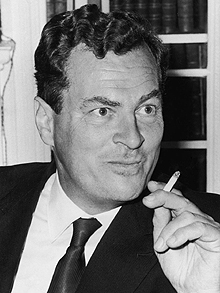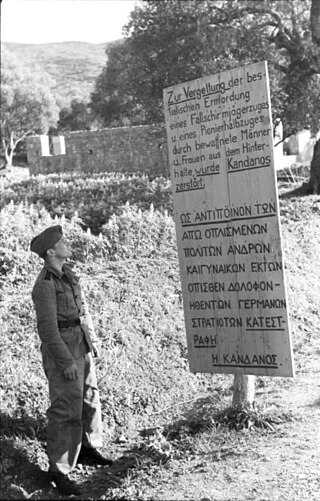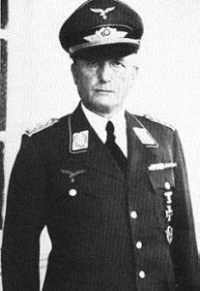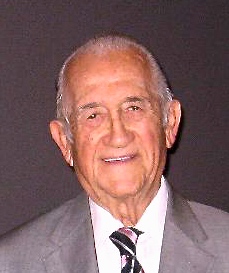
Sir Patrick Michael Leigh Fermor was an English writer, scholar, soldier and polyglot. He played a prominent role in the Cretan resistance during the Second World War, and was widely seen as Britain's greatest living travel writer, on the basis of books such as A Time of Gifts (1977). A BBC journalist once termed him "a cross between Indiana Jones, James Bond and Graham Greene".

Ill Met by Moonlight (1957), released in the US as Night Ambush, is a film by the British writer-director-producer team of Michael Powell and Emeric Pressburger, and the last movie they made together through their production company "The Archers". The film, which stars Dirk Bogarde and features Marius Goring, David Oxley, and Cyril Cusack, is based on the 1950 book Ill Met by Moonlight: The Abduction of General Kreipe by W. Stanley Moss, which is an account of events during the author's service on Crete during World War II as an agent of the Special Operations Executive (SOE). The title is a quotation from Shakespeare's A Midsummer Night's Dream, and the book features the young agents' capture and evacuation of the German general Heinrich Kreipe.

Ivan William Stanley Moss MC, commonly known as W. Stanley Moss or Billy Moss, was a British army officer in World War II, and later a successful writer, broadcaster, journalist, and traveller. He served with the Coldstream Guards and the Special Operations Executive (SOE) and is best known for the Kidnap of General Kreipe. He was a best-selling author in the 1950s, based on his novels and books about his wartime service. His SOE years are featured in Ill Met by Moonlight: The Abduction of General Kreipe, and A War of Shadows. Moss travelled around the world, including Antarctica to meet the Commonwealth Trans-Antarctic Expedition.

George Psychoundakis BEM was a member of the Greek Resistance on Crete during the Second World War and after the war an author. Following the German invasion, between 1941 and 1945, he served as the dispatch runner for the Special Operations Executive (SOE) operations on Crete, as part of the Cretan resistance. During the postwar years he was at first mistakenly imprisoned as a deserter. While in prison he wrote his wartime memoirs, which were published as The Cretan Runner. Later he translated key classical Greek texts into the Cretan dialect.

The Cretan resistance was a resistance movement against the occupying forces of Nazi Germany and Fascist Italy by the residents of the Greek island of Crete during World War II. Part of the larger Greek resistance, it lasted from 20 May 1941, when the German Wehrmacht invaded the island in the Battle of Crete, until the spring of 1945 when they surrendered to the British. For the first time during World War II, attacking German forces faced in Crete a substantial resistance from the local population. In the Battle of Crete, Cretan civilians picked off paratroopers or attacked them with knives, axes, scythes, or even bare hands. As a result, many casualties were inflicted upon the invading German paratroopers during the battle. For their resistance to the Germans, the Cretan people paid a heavy toll in the form of reprisals.

Karl Heinrich Georg Ferdinand Kreipe was a German career soldier who served in both World War I and World War II. While leading German forces in occupied Crete in April 1944, he was abducted by British SOE officers Patrick Leigh Fermor and William Stanley Moss, with the support of the Cretan resistance.

Friedrich-Wilhelm Müller was a general in the Wehrmacht of Nazi Germany during World War II. He led an infantry regiment in the early stages of the war and by 1943 was commander of the 22nd Air Landing Division. Under his orders, troops of the division committed atrocities against Greek civilians. He was later commander of occupied Crete and his harsh methods of controlling the island saw him nicknamed "The Butcher of Crete." After the war he was convicted and executed by a Greek court for war crimes.

Alexander Andrae, whose first name is often mistakenly given as Waldemar, was a German military officer from Kösling, Upper Silesia. Initially pursuing an Army career, he then joined the security police and eventually the Luftwaffe.

Angelico (Angelo) Carta was an Italian military officer, best known for his actions during the Axis occupation of Crete in World War II.

Helias Doundoulakis was a Greek American civil engineer who patented the suspension system for the at-the-time largest radio telescope in the world. During WWII he served in the United States Army and the Office of Strategic Services (OSS) as a spy.

The kidnapping of Heinrich Kreipe was an operation executed jointly by the British Special Operations Executive (SOE) and local resistance members in Crete in German-occupied Greece during the Second World War. Operation 'BRICKLAYER' was launched on 4 February 1944, when SOE officer Patrick Leigh Fermor landed in Crete with the intention of abducting notorious war criminal and commander of 22nd Air Landing Division, Friedrich-Wilhelm Müller. By the time of the arrival of the rest of the abduction team, led by William Stanley Moss, two months later, Müller had been succeeded by Heinrich Kreipe, who was chosen as the new target.

The Viannos massacres were a mass extermination campaign launched by German forces against the civilian residents of around 20 villages located in the areas of east Viannos and west Ierapetra provinces on the Greek island of Crete during World War II. The killings, with a death toll in excess of 500, were carried out on 14–16 September 1943 by Wehrmacht units. They were accompanied by the burning of most villages, looting, and the destruction of harvests.

Thomas James Dunbabin DSO, was an Australian classicist scholar and archaeologist of Tasmanian origin, as well as a renowned WWII soldier in Crete.
The Holocaust of Kedros, also known as the Holocaust of Amari, was the mass murder of the civilian residents of nine villages located in the Amari Valley on the Greek island of Crete during its occupation by the Axis powers in World War II. The massacre was a reprisal operation mounted by Nazi German forces.

Ill Met by Moonlight: The Abduction of General Kreipe is a non-fiction partly-autobiographical book written by W. Stanley Moss, a British soldier, writer and traveller. It describes an operation in Crete during the Second World War to capture German general Heinrich Kreipe. Moss kept a diary during the war years and based his book on it. The 2014 edition includes an introduction by one of Moss's children and an afterword by Patrick Leigh Fermor.

Georgios Petrakis, better known as Petrakogiorgis, was a Greek businessman, partisan, and politician. He was a leading figure in the Cretan resistance of the years 1941 – 1944 against the Axis occupation forces, well respected for his patriotism, courage, honesty, perspicacity and selflessness.
Manolis or Emmanouil Paterakis was a member of the Cretan resistance during World War II, who lived in the village of Koustogerako in the then-province of Selino. In English language sources, he also appears as Manoli Paterakis.

The Razing of Anogeia or the Holocaust of Anogeia refers to the complete destruction of the village of Anogeia in central Crete (Greece) and the murder of about 25 of its inhabitants on 13 August 1944 by German occupying forces during World War II. This was the third time Anogeia was destroyed, as the Ottomans had destroyed it twice; first in July 1822 and again in November 1867, during the Great Cretan Revolt.
Kimonas or Kimon Zografakis, frequently referred to by his nom de guerre, Black Man, was a distinguished Greek partisan in the Cretan resistance from 1941 to 1944 against the Axis occupation forces.
George James Doundoulakis was a Greek American physicist and soldier who worked under British Intelligence during World War II with SOE agent Patrick Leigh Fermor, and then served with the OSS in Thessaly, Greece.















